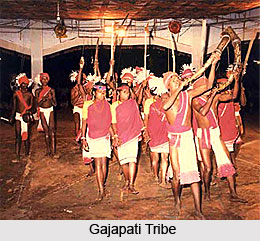 Gajapati is the dissected part of the erstwhile Ganjam district. Therefore the inhabitants of the Gajapati district belong both from the former Ganjam district and the present Gajapati. However the culture of Gajapati, in spite of being multi-ethnic , represents a culture dominated mainly by the tribals. The Saouras who are considered the oldest tribes in India are the native inhabitants of the Gajapati district.
Gajapati is the dissected part of the erstwhile Ganjam district. Therefore the inhabitants of the Gajapati district belong both from the former Ganjam district and the present Gajapati. However the culture of Gajapati, in spite of being multi-ethnic , represents a culture dominated mainly by the tribals. The Saouras who are considered the oldest tribes in India are the native inhabitants of the Gajapati district.
The cultural traditions of Gajapati district are evident from the socio-economic life of the traditional native Saouras in the district of Gajapati. The Saouras are primarily the hunter community. It is believed that that the name of the tribes has a close affinity with the occupation of the tribes. The term saora is supposed to have derived from the Scythian word "Saggoriss" meaning axe that conforms to their primitive occupation of hunting. Though in the recent times most of the areas of the Gajapati district are urbanized , in the suburban areas, the tribes predominate, hence the culture of Gajapati has the essence of tribal culture.
Following the economic set up, the Saouras are categorized into two economic classes- The Saouras of the hilly areas practicing shifting and the terrace cultivation around the hilly slopes and the Saouras of the plain land depending on the wet cultivation or wage earning and selling firewood. The socio-economic foundation and their cultural habits are significantly different from one another, which dominates the Culture of Gajapati to a large extent. The Saouras of the plains in some cases are subservient to the affluent community of the hilly areas and provides labor to them and the non-tribal communities at the time of weeding, transplanting, harvesting and other agricultural operations and sell firewood and leaf plates in the local markets.
The tribal culture of Gajapati is evident from the linear pattern of the village planning. Each of the village is consisted of two rows of houses facing each other separated by a long narrow village street .
The religious beliefs of the Saouras influenced the cultural life of Gajapati to a large extent. The spirits mainly dominates the religious life of the Saouras and their culture is marked with elaborate ceremonialism and ritualism. To control the curses of the spirits and the and to protect themselves from the evil spirits they worship various aspects of nature, they believe as the controller of those spirits.
The art and craft symbolizing the family deity, sun and moon are of anthropromorphic form. The art and craft at the same time symbolized the rural culture of Gajapati. The tribal dance is also an important facet of the cultural traits of Gajapati. Men Women and the children flocked and dance together during the ceremonies and the marriages. Except during the marriage ceremony, the religious dances are hardly accompanied with music. in some cases the dance of the Saouras, also becomes a source of earning livelihood. The dress habits of the Saouras are very simple and are supplied by the Dama caste. The dress of a lady consists of a waistcloth with a gray borders hardly reaching the knee. The men`s dress consists mainly of a loincloth. The bangles, necklace of glass, clay, kaincha or gunja laced with thread or wire plastic or horn beads, wooded and metal ear rings, brass hair pins, brass rings, little rings of nose, metal bangles and anklets etc are the principal jwellery of the Saouras. The cultural life and characteristics of the Saouras mainly constitute the cultural life and habits of Gajapati district.



















